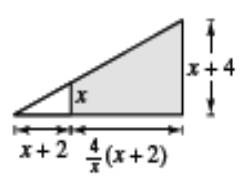
Concept explainers
Find the probability that marble will come to rest in shaded portion of the base
Answer to Problem 74E
The probability is
Explanation of Solution
Given:
The probability that the marble will come to rest in the shaded portion of the base is equal to the ratio of the shaded area to the total area of the figure.

Consider the above figure
In which the sides of the bigger triangle is
Also consider that,
The area of the bigger triangle
Also, the area of the smaller triangle
Now area of the shaded region is area of bigger triangle minus the area of smaller triangle.
Therefore area of shaded region is
Given that the probability that the marble tossed will end up at rest in the shaded portion is equal to the ratio of the area of shaded region to the area of the total figure.
Hence, the probability is
Chapter A Solutions
EBK PRECALCULUS W/LIMITS
- The answer is B, Could you please show the steps to obtain the answerarrow_forward2. Suppose that U(x, y, z) = x² + y²+ z² represents the temperature of a 3-dimensional solid object at any point (x, y, z). Then F(x, y, z) = -KVU (x, y, z) represents the heat flow at (x, y, z) where K > 0 is called the conductivity constant and the negative sign indicates that the heat moves from higher temperature region into lower temperature region. Answer the following questions. (A) [90%] Compute the inward heat flux (i.e., the inward flux of F) across the surface z = 1 - x² - y². (B) [10%] Use the differential operator(s) to determine if the heat flow is rotational or irrotational.arrow_forwardCould you show why the answer is B Using polar coordinates and the area formulaarrow_forward
- 1. The parametric equations x = u, y = u cos v, z = usin v, with Ou≤ 2, 0 ≤ v ≤ 2π represent the cone that is obtained by revolving (about x-axis) the line y = x (for 0 ≤ x ≤2) in the xy-plane. Answer the following questions. (A) [50%] Sketch the cone and compute its surface area, which is given by dS = [ | Ər Or ди მა × du dv with S being the cone surface and D being the projection of S on the uv-plane. (B) [50%] Suppose that the density of the thin cone is σ(x, y, z) = 0.25x gr/cm². Compute the total mass of the cone.arrow_forwardThe value of sin (2V · F) at x = 3, y = 3, z = −4, where F -0.592 -0.724 0.661 -0.113 -0.822 -0.313 0.171 0.427 = (-2x² + -4,2yz − x − 3, −5xz - 2yz), isarrow_forwardThe correct answer is C Could you show me whyarrow_forward
- The graph of f(x) is given below. Select each true statement about the continuity of f(x) at x = -4. Select all that apply: ☐ f(x) is not continuous at x = -4 because it is not defined at x = −4. ☐ f(x) is not continuous at x = -4 because lim f(x) does not exist. x-4 f(x) is not continuous at x = -4 because lim f(x) = f(−4). ☐ f(x) is continuous at x = -4. x-4 ين من طلب نہ 1 2 3 4 5 6 7arrow_forwardThe graph of f(x) is given below. Select each true statement about the continuity of f(x) at x = -1. -7-6-5 N HT Select all that apply: ☐ f(x) is not continuous at x = -1 because it is not defined at x = -1. ☐ f(x) is not continuous at -1 because lim f(x) does not exist. x-1 ☐ f(x) is not continuous at x = -1 because lim f(x) = f(−1). ☐ f(x) is continuous at x = -1. x-1 5 6 7arrow_forwardUse the shell method to find the volume of the solid generated by revolving the region bounded by the curves and lines about the y-axis. y=x², y=7-6x, x = 0, for x≥0arrow_forward
 Calculus: Early TranscendentalsCalculusISBN:9781285741550Author:James StewartPublisher:Cengage Learning
Calculus: Early TranscendentalsCalculusISBN:9781285741550Author:James StewartPublisher:Cengage Learning Thomas' Calculus (14th Edition)CalculusISBN:9780134438986Author:Joel R. Hass, Christopher E. Heil, Maurice D. WeirPublisher:PEARSON
Thomas' Calculus (14th Edition)CalculusISBN:9780134438986Author:Joel R. Hass, Christopher E. Heil, Maurice D. WeirPublisher:PEARSON Calculus: Early Transcendentals (3rd Edition)CalculusISBN:9780134763644Author:William L. Briggs, Lyle Cochran, Bernard Gillett, Eric SchulzPublisher:PEARSON
Calculus: Early Transcendentals (3rd Edition)CalculusISBN:9780134763644Author:William L. Briggs, Lyle Cochran, Bernard Gillett, Eric SchulzPublisher:PEARSON Calculus: Early TranscendentalsCalculusISBN:9781319050740Author:Jon Rogawski, Colin Adams, Robert FranzosaPublisher:W. H. Freeman
Calculus: Early TranscendentalsCalculusISBN:9781319050740Author:Jon Rogawski, Colin Adams, Robert FranzosaPublisher:W. H. Freeman
 Calculus: Early Transcendental FunctionsCalculusISBN:9781337552516Author:Ron Larson, Bruce H. EdwardsPublisher:Cengage Learning
Calculus: Early Transcendental FunctionsCalculusISBN:9781337552516Author:Ron Larson, Bruce H. EdwardsPublisher:Cengage Learning





